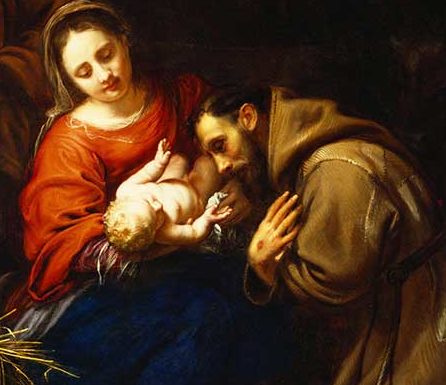Our heavenly patron, St. Francis of Assisi – (Giovanni Francesco di Bernadone) was born in 1182 and died October 3, 1226. He was the son of a wealthy cloth merchant. As a youth, Francesco – or Francis in English – was generous and fun loving, a devotee of Troubadours. His ambition was to become a knight in the service of his beloved city, Assisi. In 1201 in a battle against the neighbouring city of Perugia, Francis was wounded and taken prisoner. He returned to Assisi a year later, a physically and spiritually broken young man. Upon recovering, he was a changed person and began to experience a great longing to recognize God’s will in his life.


Mission Starts…
Not long after his return to Assisi, while praying before an ancient crucifix in the forsaken wayside chapel of the Church of San Damiano, he heard a voice saying, ‘Go, Francis, and repair my house, which as you see is falling into ruin. In 1209, Francis heard a sermon during Mass in the Chapel of St. Mary of the Angels, in which the Gospel of the day (Matthew 10:9) told how the disciples of Christ were to go forth and proclaim that the Kingdom of Heaven was upon them, that they should take no money, nor even a walking stick or shoes for the road. From there, Francis was inspired to devote himself to a life of poverty, and garbed himself in a coarse woolen tunic, worn by the poorest Umbrian peasants and tied around him with a knotted rope.
He went forth to preach penance, brotherly love, and peace, and was soon joined by his first follower, Bernardo di Quintavalle. Within a year, Francis had eleven followers. Francis led his followers to Rome to seek permission to found a new religious order. Pope Innocent II gave his approval and St. Francis called the new order the Friars Minor, that they might always regard the virtue of humility. In order to open the way to God for all who wished to imitate his life, he established s Second Order, the Order of Poor Ladies, later called the Poor Clares, and later a Third Order, intended for men and women who could not leave their homes for a cloistered life.
It was, above all, the Passion and Death of Christ on the Cross that filled Francis with love of his Savior. When he was praying on Mount LaVerna, Francis is said to have had a vision on or about September 14, 1224, the Feast of the Exaltation of the Christ. The Crucified Savior appeared to Francis in the form of a Seraph, a six-winged angel on a cross, and impressed upon him the marks of the Five Sacred Wounds, the stigmata. Francis’ attitude towards the natural world, while poetically expressed, was conventionally Christian. He believed that the world was created good and beautiful by God, but is suffers from a need for redemption. He preached to man and beast the universal ability and duty of all creatures to praise God (a common theme in the Psalms) and the duty of men to protect and enjoy nature as both stewards of God’s creation and as creatures ourselves.St. Francis died on October 3, 1226, lying on the bare ground in imitation of his Savior’s death on the Cross. St. Francis is known as the patron Saint of animals, the environment and one of the two patrons of Italy (with St. Catherine of Sienna). St. Francis was canonized in Assisi by Pope Gregory on Sunday, July 16, 1228. Following the spirit and charism of St. Francis, there arose in the church many religious and lay associations. They are a part of the Franciscan Family. St. Francis is the Patron of the Environment / ecology.


